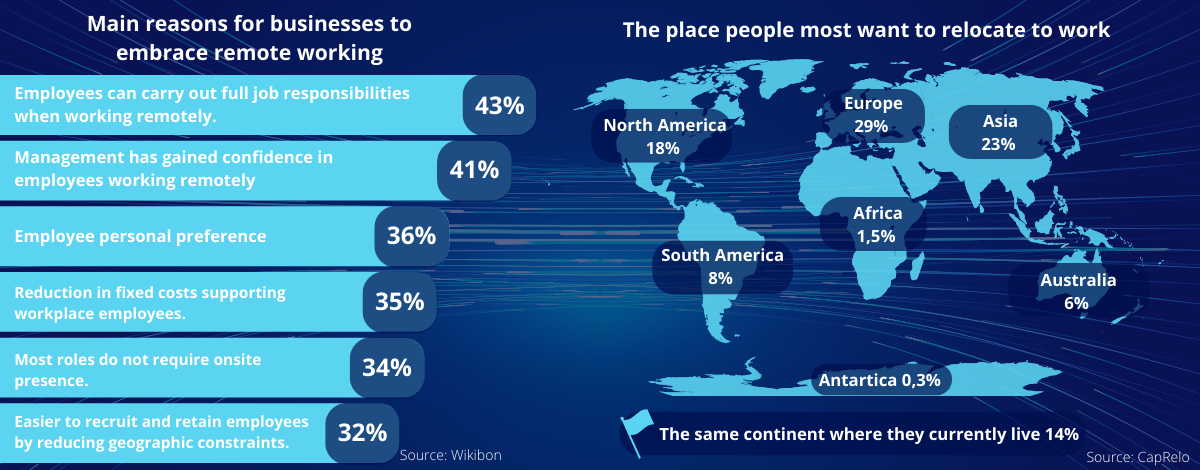Breadcrumb
Recent history has changed the way we work and both business leaders and the workforce seem to agree that there is no going back. Their prediction is that hybrid working will become the most pervasive form of work (36%), closely followed by office working (34%) and then fully remote working (29%).[1]
For business leaders, the forced rapid change to remote working during the pandemic has opened their eyes to the opportunities.[2]
[1] Source: Wikibon
[2] Source: ISC2
For employees, the freedom to choose how they work has also become important with 87% saying remote working was an important aspect of their future employment. And it’s not all about money. More time flexibility and being able to choose where they work were the top reasons for wanting more flexibility.[3]
And the place that people most wanted to relocate for work? Well, Europe came out top of the list at 29%.[4]
[3] Source: Buffer; Nomad List
[4] Source(s): CapRelo

New technology challenges
But this labour shift does not come without its challenges. Maintaining communications, innovation and company culture are the increased challenges facing companies with a distributed workforce and these can only be overcome by finding new ways for people to collaborate.
Business leaders have already recognised this, with 80% saying that digital workspaces (including collaboration tools) will be essential to their future success and that is being backed-up by investment. In the area of Unified Communications, increased spending on video meeting and collaboration apps is at the top of the investment list, with more than 50% of business leaders saying they are focusing on these areas.[5]
But increased spending does not always create the worker freedom to collaborate that business leaders hope for. In the area of video meetings, for example, workers still face challenges. 58% report technical issues, and 28% complain of too many meetings or video meeting fatigue and finding it more difficult to read people on the calls.[6]
[5] Source: Global changes in UCaaS related IT spending 2021, Statista.
[6] Global challenges experienced in video meetings 2021.
Next generation collaboration
So, how do we ensure that hybrid workers have the right technology solutions available to collaborate with freedom? Taking video calls, as an example, it’s about making the technology intuitive to use and the experience as natural as possible.
Panasonic PressIT360 is a next generation of camera speakerphone designed to take the pain out of hybrid meetings – especially for those attending remotely. It breaks the mould with horizontal 360-degree video to feel like a real meeting where everyone can be seen easily. You select the best camera layout from a variety of video views and unique facial and voice recognition technology automatically focuses on each participant as they speak and changes the layout accordingly.
To ensure every word is heard, it has a state-of-the-art speaker with background and keyboard noise suppression and seven integrated microphones with a voice recognition radius of up to 5m.
And it’s been designed to be simple and easy to use. The sleek and lightweight tower design means the device can be quickly moved from meeting room to meeting room. Just connect to a laptop with a USB Type-C cable and start the meeting with no time wasted setting-up.
This hybrid meeting system is just one of the new Panasonic PressIT collaboration tools designed for the future of work. The PressIT wireless presentation system is another example of liberating technology for new ways of working, with up to 32 devices able to connect and 4 people able to share at the same time, enabling collaboration at the touch of a button.
If you have changed the way you work, why not take a closer look at how you can supercharge your collaboration?
Read more insights…
Case Study
Vecomp Theatre: Redefining the Corporate Event Experience with Panasonic Projection
The Challenge: Transforming a Traditional Training Room into an Immersive Experience.
article
REVOLUTIONISE COMPLEX PROJECTION WORKFLOWS WITH PANASONIC SOFTWARE PLATFORM
Visual Software Suite eliminates the need for multiple tools, delivering efficient and streamlined workflows that reduce set-up time and operating costs.
Case Study
Transforming Education: TU Dublin's Mobile Hyflex Revolution Powered by PressIT360 Solution
Panasonic’s PressIT360 video conferencing solution has played a key role in enabling a flexible, future-ready learning model at TU Dublin.
Case Study
Powering a New Era of Event Innovation at Finlandia Hall with Panasonic's DLP™ and LCD projectors
Panasonic's DLP™ & LCD projectors delivered high-brightness visuals for a large-scale installation in the main auditorium and across various meeting & exhibition rooms at Finlandia Hall, where performance, reliability, flexibility and image fidelity were essential.
Sorry there was an error...
The files you selected could not be downloaded as they do not exist.
You selected items.
Continue to select additional items or download selected items together as a zip file.
You selected 1 item.
Continue to select additional items or download the selected item directly.
Share page
Share this link via:
Twitter
LinkedIn
Xing
Facebook
Or copy link: